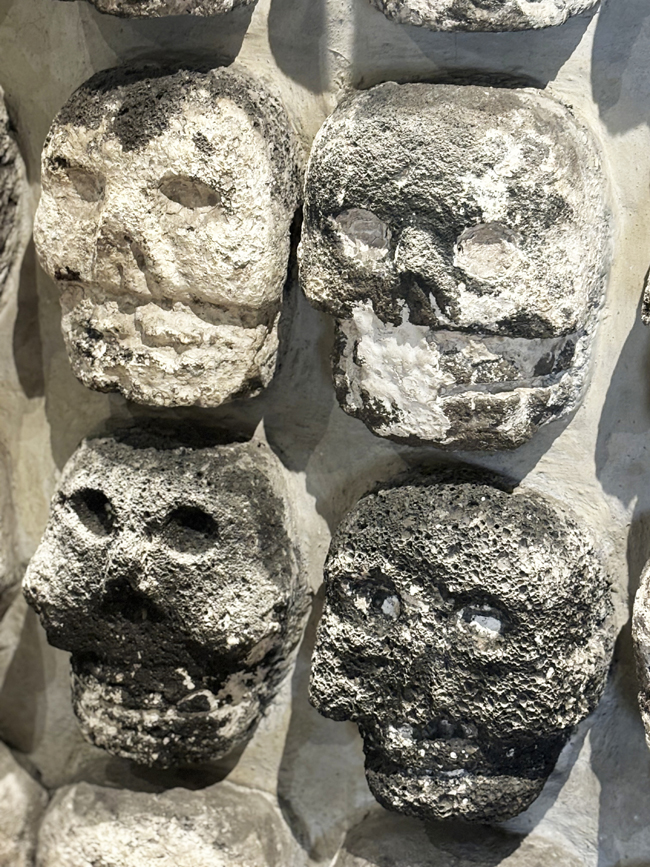We recently spent two weeks in the beating heart of Mexico City, where thousands of people were once sacrificed to the Aztec gods and blood gushed down the streets very close to the location of our hotel. It was both gruesome and fascinating.

I want to share my grisly discoveries with you, but first a word about my plans for this blog. After ten years, I’m taking a new approach to Letters From Windermere, delving into subjects that interest you (and me) the most.
This year I will focus on three basic themes: HISTORY, WRITING, and BOOKS.
History Through My Eyes
Back when this blog was called Wartime Wednesdays, I shared stories and interviews from the Second World War. Although I transitioned to a more personal blog five years ago, many of you still share my passion for history.
So this year, I will share facts and photos about people and incidents from the past that get me fired up. Although my current focus is pioneer and indigenous history, I love learning about the past in general, everything from old houses to museums, mainly through research or travel.
But I’ve NEVER heard anything like the story behind Mexico City.
Bloody Mexico City
This sprawling metropolis of 23 million inhabitants was founded around 1325 by the Aztecs, the most powerful people on the continent at that time. The Aztecs ruled the vast area covering what is now called Mexico and beyond, subduing the other indigenous peoples with brutal force.
The Aztecs had created a thriving city of 200,000 people called Tenochtitlan, larger than any city in Europe at the time, when the Spaniards arrived in 1519 and after fierce battles that lasted for months, the Aztecs went down to bitter defeat.
Although the Aztecs built temples all over the region, the main one was a huge pyramid-shaped temple in the centre of the ruling city. The Spaniards immediately tore down this massive pyramid, using the stones to build their own Metropolitan Cathedral right next to it.
Here is the magnificent cathedral in Mexico City today, itself a historic treasure.

The Spaniards looted and demolished most of the Aztec city, enslaving and working their prisoners to death. They also created their own city centre square, now called the Zocalo, with the ornate cathedral on one side flanked by the National Palace on the left, the seat of government that is occupied by the current Mexican president, Andres Manuel Lopez Obrador.

The square is completed with other magnificent old sandstone government buildings, plus hotels and restaurants.
But back in the day, the Aztec pyramid would have dwarfed all these buildings. An artist’s rendition shows the relative size of the pyramid called Templo Mayor (Major Temple) compared to the cathedral in front and the National Palace on the left. (On the farthest corner of the square was our hotel, the Gran Hotel Mexico City.)

Four centuries passed, during which the Aztec culture was largely buried and forgotten. But in 1978, electrical workers in Mexico City were excavating a city street when they stumbled across this huge carved stone, ten feet in diameter. It depicts a headless female deity being dismembered, a warning to all Aztec enemies.

This discovery convinced the government to launch a major excavation project. They tore down some of the older buildings around the square and started to dig. Here I am standing beside the remains of Templo Mayor, with the cathedral in the background.

Hundreds of priceless artifacts have been unearthed, some of them very sophisticated – although most will remain forever buried beneath downtown Mexico City. For example, in 1994 archaeologists found this statue of the grinning Aztec god of the dead, Mictlantecuhtli, by burrowing through a tunnel underneath a busy street.
His hands are claws and his head has holes where the Aztecs placed curly human hair. From his stomach hangs a huge liver, the organ that was home of the spirit and associated with death.

One of the more macabre aspects of this excavation was the discovery of six hundred (so far) human skulls, since the Aztec believed that their gods needed human sacrifices.
The victim would lie on his back on a sacrificial stone, and the Aztec priest would cut out his heart with a sharp blade. Still beating, the heart would be held toward the sky in honor to the gods!
The bleeding remains would then be tossed down the stairs to the foot of the pyramid.
This stone “skull rack” still exists at Templo Mayor, with the cathedral in the background, representing just a few hundred of the men, women and even children who had their hearts cut out.

Inside the museum actual human skulls and bones are displayed.

The sheer number of human sacrifices is appalling. Historians differ, but it is estimated that between 20,000 and 80,000 humans were sacrificed here over a four-day period. The streets around the main square must have been flooded with human blood!
Whenever we stepped outside our hotel, I gave a little shudder as I imagined the air filled with the dying screams of all those people!
If this period of history captures your imagination, my husband is currently reading Aztec, by Gary Jennings, a historically accurate epic novel that was a blockbuster when first published in 1980.
The Gran Hotel Mexico City
And now for the good news. In spite of the area’s grisly past, we loved staying right in the heart of this wonderful historic city, filled with Spanish-style architecture, galleries and museums.
The Gran Hotel Mexico City, overlooking the Zocalo, is perfectly lovely and central to the city’s important sights. We walked everywhere and never took a cab once.

The showpiece of this five-storey Art Nouveau hotel, built in 1895 as a shopping centre and converted to a hotel in 1968, is the stained Tiffany glass ceiling created by French designer Jacques Gruber. It even has a beautiful wrought iron elevator, shown here.


You know how I love old hotels, and this one was just filled with atmosphere!
* * * * *
Wartime Wednesdays Flashback
Each month I’ll feature one of the stories I wrote for my previous blog, Wartime Wednesdays. They are “evergreen,” meaning they never get dated.
Yvonne Valleau Wildman was a Royal Canadian Air Force veteran who passed away in December 2023 at the age of 100 years. This photo was taken at a book signing in 2018 at McNally Robinson Books in Saskatoon, Saskatchewan.
Please read about Yvonne’s stellar service record here: RCAF Photographer Yvonne Valleau Wildman.
Rest in Peace, Yvonne Valleau Wildman.

* * * * *
My Writing Journey
As a writer, why don’t I write about what I do best? I’ve been reluctant for a few reasons:
- There are a million websites out there about writing.
- I want to interact with readers, not other writers.
- Talking about your writing supposedly drains your creative energy.
Having said that, I find that people at my book events always ask where I get my ideas, how I conduct my research, and how long it takes me to write a book.
So this year I’ll give YOU, my valued subscribers, a front-row seat in the journey toward publishing my new novel about homesteading on the Canadian prairie.
My Standing Desk
I’ll begin by showing you where I’m currently working.
This is my writing desk for the next couple of months. We are settled into our usual rental accommodation in Puerto Vallarta, a city on the Mexican west coast. Our condo is perched high on the mountainside above Los Muertos Pier, with a sweeping view of Banderas Bay.
Here we do not engage in the resort lifestyle (my tanning days are over, plus I have hated tequila ever since an incident at Carleton University in my youth which I’m trying to forget). Instead, we pretty much carry on our lives as usual, albeit in a warm and sunny environment.
For the sake of my spine, I stand up when I write. I took the bottom drawer from this small carved dresser, turned it upside down, and together with a stack of books I found in the condo, my laptop is now the perfect height. I stand on a soft rug to spare my feet from the tile floor. Best of all is my view of the jungle and the ocean.
Here I write my blog, answer emails, and work on manuscript revisions. (Until the book appears in print, the work seemingly never ends.)

* * * * *
Book of the Month
Since many of you are avid readers, this year I’ll recommend one book each month. I just finished August Into Winter by the brilliant Canadian author Guy Vanderhaeghe, perhaps best known for his Western novels The Last Crossing and The Englishman’s Boy. This work of historical fiction is based on a true crime that took place in Saskatchewan in 1939. It has great characters, a thrilling plot, and fine writing.

In case you need more reading material, here are some of my previous recommendations:
* * * * *
New Year, New Focus
I made four New Year’s resolutions last year and I met them all!

However, in 2024 my only resolution is to please you, dear subscribers, by producing content that you enjoy as much as I do!
Your feedback is welcome. Send me an email, or post your comments below so everyone else can read them, too.
Although I’m off to a late start due to our travels, this year I will send Letters From Windermere on the THIRD Wednesday of each month. Mark it on your calendar and check your junk mail folder if you can’t find it, or send me an email and ask me where it is!
WATCH FOR MY NEXT BLOG POST ON WEDNESDAY, FEBRUARY 21, 2024.
And please, do share Letters From Windermere with friends who might be interested.
Onwards and upwards!
Elinor
Thank you for reading this post. Don't forget to subscribe!
